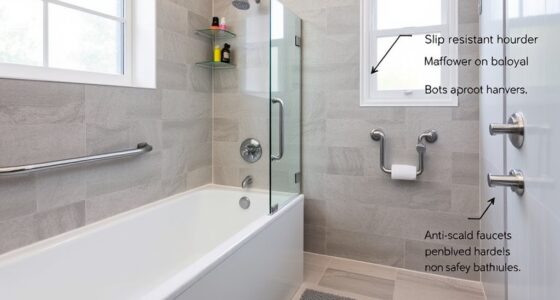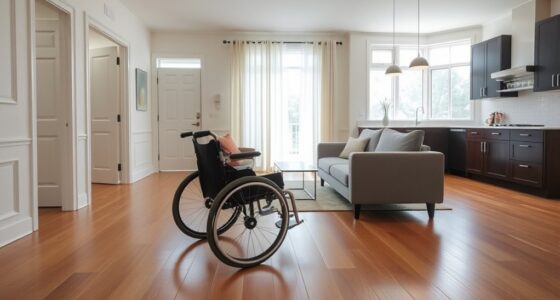To keep your non-slip mats secure in the bathroom, start by thoroughly cleaning and drying the floor to guarantee good adhesion. Use double-sided tape or waterproof adhesive spray, applying carefully and pressing firmly. For additional hold, place a weight on the mat for a few hours. Regularly check and reapply adhesive if needed. If you want effective and long-lasting results, there’s more to take into account for safety and stability.
Key Takeaways
- Clean and dry the bathroom floor thoroughly before applying any adhesive or tape for optimal grip.
- Use double-sided tape or non-slip rug pads designed for bathroom surfaces to secure mats effectively.
- Press the mat firmly onto the floor and place weights during the initial set period for better adhesion.
- Regularly inspect the mat and reapply adhesive or reposition as needed to prevent slipping.
- Choose waterproof, safe adhesives compatible with bathroom surfaces to ensure long-lasting security.

Have you ever slipped on a bathroom floor despite having a non-slip mat? It’s a frustrating experience that can lead to injuries, especially in such a wet environment. One common reason for this is that mats aren’t secured properly, making them shift or bunch up when you step on them. To truly keep yourself safe, you need to guarantee your mat stays firmly in place, and that’s where understanding adhesive options and installation tips becomes essential.
First, explore the adhesive options available for securing your non-slip mat. There are several types of adhesives designed specifically for bathroom use, including double-sided tape, non-slip rug pads, and adhesive sprays. Double-sided tape is popular because it’s easy to apply and provides instant grip. Look for tapes that are waterproof and designed for textured surfaces like tile or vinyl. Non-slip rug pads are another great choice; they offer a cushioned layer that grips both the floor and the underside of the mat, preventing slipping. Adhesive sprays are also effective but require careful application to avoid mess and guarantee even coverage. When choosing an adhesive, make sure it’s suitable for your floor type and safe for bathroom environments, especially if you have children or pets.
Installation tips play a vital role in making sure your non-slip mat stays put. Before applying any adhesive, thoroughly clean and dry the bathroom floor. Dirt, soap scum, and moisture can weaken the grip of adhesives, so wiping the area with a mild cleaner and letting it dry completely is essential. When applying double-sided tape or adhesive spray, follow the manufacturer’s instructions carefully. Press the mat firmly onto the floor, making sure to smooth out any air bubbles or wrinkles. For added security, consider placing a few weights or heavy objects on the mat for a few hours after installation. This helps the adhesive set properly and guarantees the mat adheres evenly across its surface. Regularly check your mat’s position and reapply adhesive if it starts to lift or shift. Additionally, avoid placing the mat in areas prone to constant water splashes or where it might become overly wet, as this can weaken the adhesive over time. Recognizing the importance of dog breeds and their traits can also help in choosing a suitable grip for pet-friendly environments, ensuring safety for both humans and animals.
Frequently Asked Questions
Can Non-Slip Mats Be Reused After Cleaning?
Yes, you can reuse non-slip mats after cleaning, as long as they maintain their mats durability. Regular cleaning, depending on frequency, helps remove soap scum and dirt that might reduce grip. Make sure you thoroughly dry the mats to prevent mold. If the mats show signs of wear or damage, it’s best to replace them for safety. Proper maintenance extends their lifespan and keeps your bathroom safe.
Are There Environmentally Friendly Options for Securing Mats?
Imagine a cleaner, greener bathroom where your choices plant seeds for the future. You can secure mats using environmentally friendly options like biodegradable adhesives or eco-friendly tapes. These alternatives are safe for both your family and the planet, providing strong grip without harmful chemicals. By choosing eco-conscious adhesives, you make a positive impact, turning everyday routines into acts of environmental kindness.
How Often Should Non-Slip Mats Be Replaced?
You should replace your non-slip mats every 6 to 12 months to guarantee maximum safety. Mats’ longevity depends on factors like usage, cleaning, and material quality. Regularly check for signs of wear, such as thinning, peeling, or mold. If you notice any damage or the grip is diminished, it’s time for replacement. Doing so keeps your bathroom safe and maintains the effectiveness of the mats over time.
Do Different Bathroom Surfaces Require Different Securing Methods?
Securing non-slip mats is like fitting a puzzle piece perfectly; different bathroom surfaces need specific methods. You should consider adhesive types suited for your surface, such as silicone-based for tiles or rubber-backed options for acrylic. The mat material also matters—some adhesives work better with rubber or fabric mats. By matching the right adhesive with your surface and mat, you guarantee it stays put, reducing slips and increasing safety.
Can Securing Methods Cause Damage to Bathroom Flooring?
Yes, securing methods can cause damage to your bathroom flooring. Using strong adhesives might lead to floor damage or leave adhesive issues behind, especially on delicate surfaces like tile or vinyl. To avoid this, opt for non-invasive options like suction cups or double-sided tape designed for bathroom use. Regularly check the mats to prevent slipping without risking floor damage or adhesive problems over time.
Conclusion
By securing your non-slip mats properly, you not only prevent accidents but also create a safer bathroom environment. It’s a simple step, yet it often coincides with fewer slips just when you need peace of mind most. When you take the time to make sure your mats stay put, you might find yourself unexpectedly more confident in your daily routines. After all, safety often hinges on small details—details that, when addressed, make all the difference.









